The Immunochromatography Kits Market is estimated to be valued at USD 9.5 billion in 2025 and is projected to reach USD 14.2 billion by 2035, registering a compound annual growth rate (CAGR) of 4.1% over the forecast period.
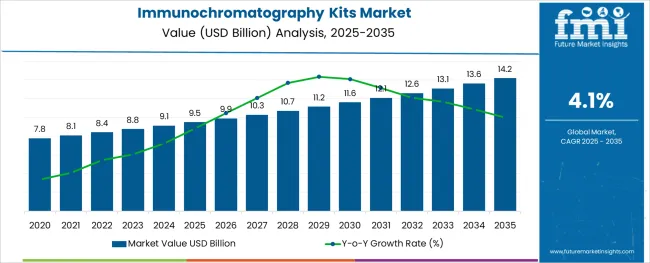
The immunochromatography kits market is undergoing significant growth due to rising demand for point of care diagnostics, increased incidence of infectious diseases, and the need for rapid and reliable testing in both clinical and remote settings. The ability of these kits to deliver results without requiring complex equipment or highly trained personnel has driven their adoption across emerging economies and decentralized healthcare systems.
Continuous advancements in assay sensitivity, multiplexing capabilities, and the integration of digital readers are supporting widespread clinical adoption. Public health initiatives focusing on early detection and disease containment are also promoting regular use of immunochromatographic testing, particularly in screening and monitoring applications.
The future outlook is positive as healthcare systems continue to prioritize accessibility, speed, and diagnostic efficiency, making these kits integral to modern diagnostic pathways in both urban and rural infrastructures.
The market is segmented by Product, Application, and Distribution Channel and region. By Product, the market is divided into Readers and Kits. In terms of Application, the market is classified into Sexually Transmitted Diseases, Infectious Diseases, Diabetes, Pregnancy Testing, Drug Abuse Testing, and Others. Based on Distribution Channel, the market is segmented into Hospital Pharmacies, Retail Pharmacies, Supermarket/Hypermarket, and E-Commerce. Regionally, the market is classified into North America, Latin America, Western Europe, Eastern Europe, Balkan & Baltic Countries, Russia & Belarus, Central Asia, East Asia, South Asia & Pacific, and the Middle East & Africa.
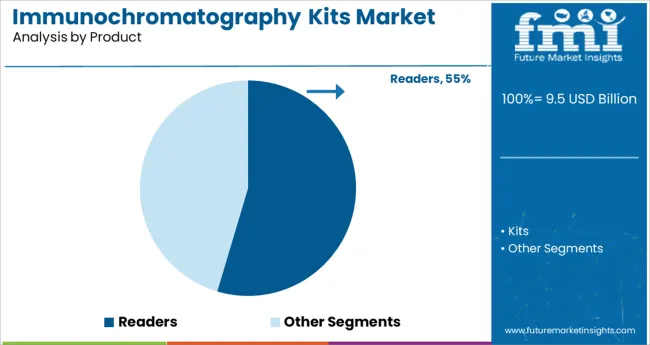
The readers segment is projected to contribute 54.60% of total market revenue by 2025 within the product category, making it the most prominent segment. This growth is being driven by the increasing need for accurate interpretation of test results, enhanced data traceability, and integration with digital health records.
Readers offer consistent result analysis, reduce operator error, and support quantitative output, which is critical in clinical decision making. Their utility in high throughput testing environments and compatibility with a broad range of assays make them valuable assets in laboratories, hospitals, and field diagnostics.
As healthcare moves toward connected and automated diagnostic workflows, the adoption of readers continues to expand, solidifying their leadership in the product segment.
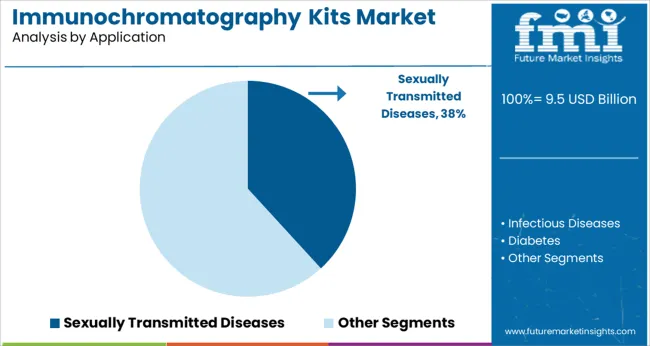
The sexually transmitted diseases application segment is expected to account for 38.20% of the total market revenue by 2025, positioning it as the leading application area. This is attributed to the growing global prevalence of sexually transmitted infections, heightened public awareness, and targeted screening programs supported by governments and non governmental organizations.
Immunochromatography kits offer a rapid, accessible, and low cost method for early detection, particularly beneficial in resource limited and high risk populations. Their use in home based testing and community health programs has further improved diagnosis rates and patient compliance.
The reliability and ease of use of these kits have reinforced their role in STI prevention strategies, establishing sexually transmitted diseases as the dominant application area within the immunochromatography kits market.
The market value for immunochromatography kits was approximately 22.9% of the overall ~USD 9.1 Billion of the global immunoassay market in 2024.
The sale of immunochromatography kits expanded at a CAGR of 4.2% from 2012 to 2024.
Immunochromatography kits are unquestionably one of the most effective analytical tools for on-site target identification. Immunochromatography, which is analogous to a lab-in-a-hand, along with other point-of-need diagnostics, has marked a paradigm change from lab-to-lab to lab-to-sample intended to enable faster decision-making and turnaround time. Immunochromatography kits have a number of characteristics that make them a desirable resource for clinical diagnostics, where they can enhance patient care by facilitating faster treatment and diagnosis decisions.
Widespread acceptance of immunochromatography kits is a result of their efficiency, simplicity, relative affordability, and ability to be used by unskilled individuals. Public health continues to be seriously endangered by hepatitis B. According to the World Health Organization's bulletin from 2020, it is estimated that more than 257 million individuals worldwide have chronic hepatitis B infection and that about 9 million have died from liver failure, hepatocellular carcinoma, liver cirrhosis, and other diseases linked to HBV.
The most widely used serological marker for the screening, diagnosis and evaluation of antiviral therapy for hepatitis B is hepatitis B surface antigen (HBsAg), which is the envelope protein of HBV. Due to their numerous benefits, such as ease of use, low cost, and quick turnaround time, immunochromatography kits have been extensively used in HBV screenings, including self-examinations, medical checks, donating blood, and emergency, and epidemiologic surveys.
The prevalence of cancer is gradually rising, which is anticipated to increase the need for efficient diagnostic tools like immunoassay. This method is important for determining oncogenesis and diagnosing cancer in all of its forms, including benign and malignant cancer.
Globally, the use of immunoassay-based diagnostics is steadily rising. The control of the epidemic disease is greatly aided by public awareness initiatives that educate the public about the signs of infectious diseases and how to prevent them. As a result, there is a significant demand for immunochromatography kits due to greater patient awareness.
Because of the aforementioned factors, it is anticipated that from 2025 to 2035, the global immunochromatography kits market will expand at a CAGR of 4.1%.
Since there are more infectious pathogens causing dangerous diseases globally, the development and implementation of rapid diagnostic technologies are urgently needed. Early interventions can make a significant difference in the severity of any disease epidemic by reducing the number of cases.
In recent years, researchers have thought about using more difficult and expensive immunoassay techniques, such as radioimmunoassay and ELISA, in place of the construction of quick, precise, and sensitive approaches.
The majority of these approaches rely on agglutination, immunochromatography (ICG), and several molecular methods. In hospitals, clinics, doctor's offices, and clinical labs, ICG tests are utilized for the qualitative and quantitative detection of a wide range of antigens and antibodies. Additional diagnostic alternatives for parasitic diseases are offered by the novel immunochromatography technology, which may be examined and contrasted with existing conventional diagnostic approaches.
For the diagnosis of parasitic infections such as intestinal parasite protozoa, leishmaniasis, filariasis, trypanosomiasis, trichomoniasis, toxoplasmosis, and others, a number of ICTs have been developed. A number of immunochromatography kits based primarily on the detection of several parasite antigens (and antibodies in certain tests) have recently been developed for the diagnosis of parasitic infections, and the findings are encouraging. Researchers for the identification of various parasite infections have recently evaluated Immunochromatography kits.
Although immunochromatography kits have been around for a while and can be used in the field, there is currently no conclusive data on how well they perform in addressing specific diseases. In terms of performance, scientists concur that immunochromatography kits are a potential tool for diagnosing parasite infections and are reasonably reliable in differentiating between positive and negative people.
Immunochromatography kits are thus a potentially valuable supplement to existing diagnostic tools for parasitic illnesses, providing manufacturers with lucrative opportunities for expansion in the global market during the forecast period.
Despite being widely used as the gold standard approach, the use of immunochromatography kits has certain drawbacks.
False-negative results can happen as a result of poor specimen quality, such as when the sample is taken at an inopportune time relative to the onset of the illness, or owing to improper specimen handling or shipping to the laboratory department. False positive results might also be the result of contamination or technical aspects.
Since the detection of an immune response to the virus is an indirect indicator of infection, unlike molecular testing, the development of reliable serological tests and their proper application are crucial to support ongoing public health efforts for effective epidemic prevention.
In order to achieve a quantitative improvement using immunochromatography, additional detecting equipment is needed. The immunoassay method also has a lot of disadvantages when used as an easy and affordable sensing method for domestic or personal use.
Additionally, because it is a one-step assay, the total volume in the test is limited, putting a cap on the sensitivity. Moreover, the analysis is reliant on the characteristics of the sample, including sample viscosity. These are some of the factors restraining the market for immunochromatography kits' adoption globally.
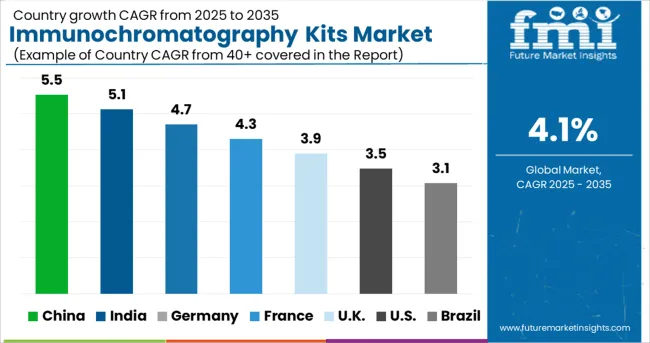
With a market share of 82.8% in all of North America in 2024, the USA presently dominates the region and is expected to sustain this growth throughout the forecast period.
This can be attributable to two factors: the simple accessibility of technologically enhanced diagnostic tools, as well as the increased demand for diagnostics brought on by the rise in cancer incidence. The high prevalence of infectious diseases including HIV, TB, and influenza in the region is also driving up the demand for treatment and diagnostic services.
China represents roughly 60.1% of the East Asia market in 2024, with growth at a lucrative CAGR of 4.8% throughout the forecast period. The growing aging population within the country, as well as the wide prevalence of chronic and infectious diseases, presents this growth. Moreover, with the rapidly enhancing healthcare structure in the country, the market for immunochromatography kits is set to advance at a high rate over the forecasted years.
Moreover, with the advent of the COVID-19 pandemic, the country presented a greater adoption of immunochromatography kits for the rapid detection of the SARS COV-2 antigen, for the effective management of infection and its prevention.
During the forecast years, Germany is projected to grow at a CAGR of nearly 3.7% in the global immunochromatography kits market. Germany holds the presence of established key players within the global immunochromatography space. Key players like Qiagen have posed a dominant hand in the distribution and development of novel point-of-need diagnosis, thus presenting Germany with a larger market share of around 24.9% within the European market, in 2024.
Moreover, growing awareness of infection prevention, as well as the presence of reimbursement for treatment, has aided Germany with lucrative growth opportunities during the forecast period.
Kits are expected to present high growth at a CAGR of 4.2% throughout the forecast period. The benefits of immunochromatography kits include a small sample amount, portable devices, and the absence of the requirement for huge and expensive equipment. Immunochromatography kit technology and design today substantially dismiss previous concerns about their specificity, accuracy, and reproducibility.
The application of immunochromatography kits for the detection of infectious diseases holds a share of around 34.5% in 2024, and this segment is expected to display gradual growth over the forecast period. Immunochromatography assays (ICA), which detect antibodies against pathogens, have been routinely utilized to diagnose a variety of infectious diseases. Rapid direct tests (viral protein screening) have an advantage over indirect ELISA tests (serology) in the case of immunocompromised patients since these patients do not have antibody levels that are high enough to be identified, thus propelling demand for immunochromatography kits for infectious disease detection.
Hospital pharmacies held the highest market share value of 36.5% during the year 2024. Being the prime source for the distribution of immunochromatography kits, this segment is expected to expand at a CAGR of 4.0% during the forecast period. Moreover, point-of-care tests are highly useful for repeat follow-up tests to check treatment progress or for continuous monitoring of a specific analyte. Point-of-care testing substantially shortens the turnaround time, which is crucial and very helpful in addressing serious conditions like heart disease.
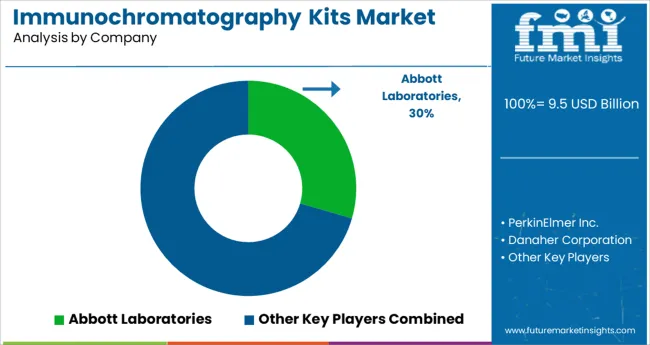
To increase their market position, major competitors in the immunochromatography kits market are using a variety of organic and inorganic methods, including alliances, mergers, and acquisitions, geographic growth, and strategic collaborations.
Similarly, recent developments related to companies manufacturing immunochromatography kits have been tracked by the team at Future Market Insights, which are available in the full report.
| Attribute | Details |
|---|---|
| Forecast Period | 2025 to 2035 |
| Historical Data Available for | 2012 to 2024 |
| Market Analysis | million for Value |
| Key Regions Covered | North America, Latin America, Europe, South Asia, East Asia, Oceania, and Middle East & Africa |
| Key Countries Covered | USA, Canada, Brazil, Mexico, Argentina, UK, Germany, Italy, Russia, Spain, France, BENELUX, India, Thailand, Indonesia, Malaysia, Japan, China, South Korea, Australia, New Zealand, Turkey, GCC Countries, North Africa, and South Africa |
| Key Market Segments Covered | Product, Application, Usage, Distribution Channel, and Region |
| Key Companies Profiled | Abbott Laboratories; PerkinElmer Inc.; Danaher Corporation; Bio-rad Laboratories; F. Hoffmann-La Roche AG; bioMérieux SA; Becton, Dickinson, and Company; Siemens Healthineers AG; Thermo Fisher Scientific Inc.; QIAGEN |
| Pricing | Available upon Request |
The global immunochromatography kits market is estimated to be valued at USD 9.5 billion in 2025.
It is projected to reach USD 14.2 billion by 2035.
The market is expected to grow at a 4.1% CAGR between 2025 and 2035.
The key product types are readers and kits.
sexually transmitted diseases segment is expected to dominate with a 38.2% industry share in 2025.






Full Research Suite comprises of:
Market outlook & trends analysis
Interviews & case studies
Strategic recommendations
Vendor profiles & capabilities analysis
5-year forecasts
8 regions and 60+ country-level data splits
Market segment data splits
12 months of continuous data updates
DELIVERED AS:
PDF EXCEL ONLINE
Hip Kits Market Size and Share Forecast Outlook 2025 to 2035
Oiler Kits Market Size and Share Forecast Outlook 2025 to 2035
Audio Kits Market
RT-PCR Kits Market Growth - Trends & Forecast 2023 to 2035
Lavage Kits Market
Organoids Kits Market
Connector Kits Market
Capacitor Kits Market
Extraction Kits Market Analysis - Size, Share, and Forecast Outlook 2025 to 2035
DIY Haircut Kits Market - Trends, Growth & Forecast 2025 to 2035
EMI, Filter Kits Market
Nephelometry Kits Market Size and Share Forecast Outlook 2025 to 2035
Analysis and Growth Projections for Chilled Meal Kits Market
1-Step RT-PCR Kits Market Size and Share Forecast Outlook 2025 to 2035
Demining Tool Kits Market Size and Share Forecast Outlook 2025 to 2035
Antibody Pair Kits Market
Skin Traction Kits Market
Grease Fitting Kits Market Size and Share Forecast Outlook 2025 to 2035
Flu Protection Kits Market Size and Share Forecast Outlook 2025 to 2035
Guided Surgery Kits Market Size, Growth, and Forecast for 2025 to 2035

Thank you!
You will receive an email from our Business Development Manager. Please be sure to check your SPAM/JUNK folder too.
Chat With
MaRIA